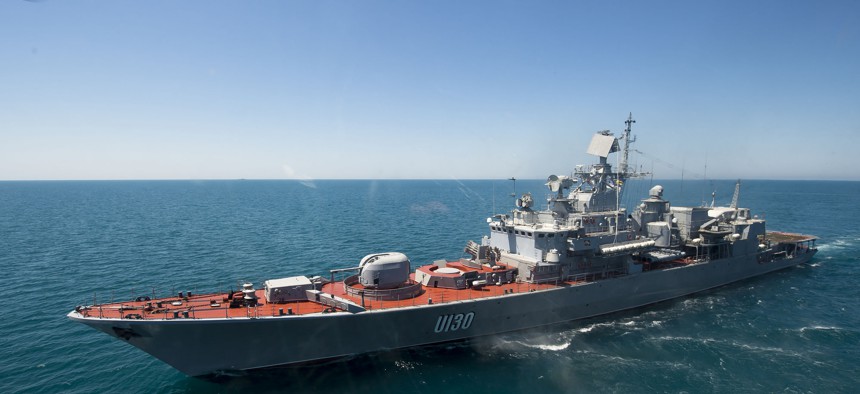
The Ukrainian navy frigate Hetman Sahaydachniy (U 130) transits the Black Sea during an underway exercise with USS Ross (DDG 71) June 2, 2015. U.S. Navy photo by Mass Communication Specialist 3rd Class Robert S. Price
Ukraine Aims To Rebuild Navy
A year after Russian soldiers seized Crimea and most of the Ukrainian fleet, Kiev is sniffing around for new ships.
The much-diminished Ukrainian Navy wants new warships, but getting them will be difficult.
Ukraine lost about two-thirds of its fleet when Russia annexed Crimea in early 2014; the Black Sea peninsula was home to most of Kiev’s warships and its naval headquarters at Sevastopol. The Ukrainian Navy now has about 5,000 sailors and about a dozen ships.
That’s enough to hold international exercises, at least. This week, Ukrainian vessels will drill in the Black Sea warships from 10 other countries, including the U.S. Navy.
Ahead of the exercise, Ukrainian Prime Minister Arseniy Yatsenyuk met Monday in Odessa with Vice Adm. James Foggo, who commands the U.S. Navy’s 6th Fleet and is deputy commander of U.S. Naval Forces Europe.
At the meeting, Foggo said, Yatsenyuk “made it quite clear to me in both private and open office calls that he values a navy and that he would look forward to modernizing it...Perhaps bringing in some new warships as their budget will support.”
Foggo said the Ukrainians did not request any specific arms during his visit.
Over the past year, the Ukrainian Army has garnered headlines as it battles Russian-backed separatists in the eastern part of the country. The pro-Europe government in Kiev has pressed the United States and other NATO members for land-warfare arms.
But Ukraine has been asking for naval arms as well. “With a real threat to our country, our Navy must be modern, high-tech, and have the ability to easily work with NATO member countries,” Ukrainian President Petro Poroshenko said in April.
Analysts have noted this desire. “Though its forces are much depleted, Kiev maintains an aspiration to develop its naval capability,” Tom Waldwyn, an analyst with the London-based International Institute for Strategic Studies wrote in April.
And the leader of the U.S. Sixth Fleet knows it, too. Foggo visited the frigate Hetman Sahaydachniy, the flagship of the Ukrainian Navy. He described it as a “very well-maintained, professional warship.” The remaining ships in Odessa, all Russian-built, are auxiliary, command and mine-countermeasure ships.
“There is an interest in working a modernization program for those vessels,” Foggo said.
The Ukrainian Navy abandoned Sevastopol after the Russian invasion, but wants to return there, Foggo said.
“They clearly understand the value of a Navy,” he said.
That’s underlined by the 11-country exercise about to commence in the Black Sea. Bringing together some 18 ships, 1,500 sailors, and various aircraft, the drills will focus on interdicting ships and boarding them, anti-submarine warfare, search-and-rescue, salvage ops and anti-terrorism.
The American admiral said Ukraine raised the possibility of impromptu drills with U.S. warships operating in the Black Sea in the future. “We’ve tried to maintain near-continuous presence in the Black Sea because it is an important region,” Foggo said.
Russian warships are typically waiting for U.S. Navy vessels after they pass through Turkey’s Bosphorus Strait into the Black Sea. That was the case a few days ago when the guided missile destroyer Donald Cook arrived to take part in the upcoming exercise.
Generally speaking, the Russian ships operate professionally but don’t always communicate with the American visitors. And overall, there has been little interaction between the U.S. and Russian military commanders since Moscow annexed the Crimean peninsula from Ukraine. Most interaction that has taken place is between the crews of warships and aircraft that encounter each other in international airspace and seas.
“When we are at sea and our warships encounter one another, we communicate the way we do with any other navy,” Foggo said. This includes radio calls and flashing lights. “Sometimes they respond. Sometimes they do not.”
This time, Foggo said, the waiting Russian frigate hailed the Donald Cook, and welcomed its commanding officer, Cmdr. Chuck Hampton, by name.
“It was cordial,” he said.
